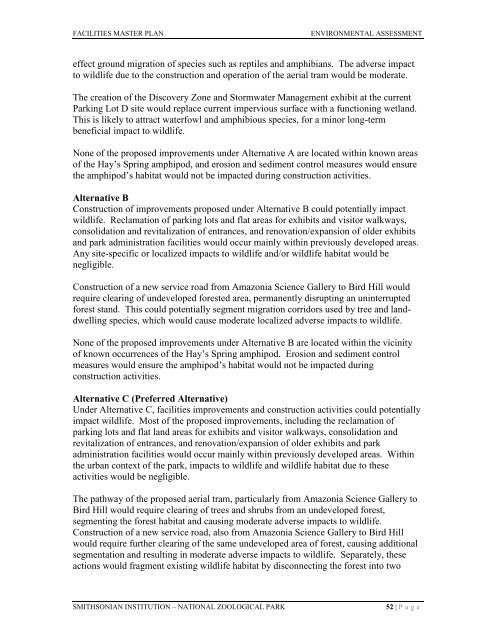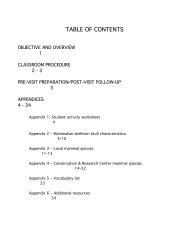facilities renewal master plan - National Zoo - Smithsonian Institution
facilities renewal master plan - National Zoo - Smithsonian Institution
facilities renewal master plan - National Zoo - Smithsonian Institution
Create successful ePaper yourself
Turn your PDF publications into a flip-book with our unique Google optimized e-Paper software.
FACILITIES MASTER PLAN ENVIRONMENTAL ASSESSMENT<br />
effect ground migration of species such as reptiles and amphibians. The adverse impact<br />
to wildlife due to the construction and operation of the aerial tram would be moderate.<br />
The creation of the Discovery Zone and Stormwater Management exhibit at the current<br />
Parking Lot D site would replace current impervious surface with a functioning wetland.<br />
This is likely to attract waterfowl and amphibious species, for a minor long-term<br />
beneficial impact to wildlife.<br />
None of the proposed improvements under Alternative A are located within known areas<br />
of the Hay’s Spring amphipod, and erosion and sediment control measures would ensure<br />
the amphipod’s habitat would not be impacted during construction activities.<br />
Alternative B<br />
Construction of improvements proposed under Alternative B could potentially impact<br />
wildlife. Reclamation of parking lots and flat areas for exhibits and visitor walkways,<br />
consolidation and revitalization of entrances, and renovation/expansion of older exhibits<br />
and park administration <strong>facilities</strong> would occur mainly within previously developed areas.<br />
Any site-specific or localized impacts to wildlife and/or wildlife habitat would be<br />
negligible.<br />
Construction of a new service road from Amazonia Science Gallery to Bird Hill would<br />
require clearing of undeveloped forested area, permanently disrupting an uninterrupted<br />
forest stand. This could potentially segment migration corridors used by tree and landdwelling<br />
species, which would cause moderate localized adverse impacts to wildlife.<br />
None of the proposed improvements under Alternative B are located within the vicinity<br />
of known occurrences of the Hay’s Spring amphipod. Erosion and sediment control<br />
measures would ensure the amphipod’s habitat would not be impacted during<br />
construction activities.<br />
Alternative C (Preferred Alternative)<br />
Under Alternative C, <strong>facilities</strong> improvements and construction activities could potentially<br />
impact wildlife. Most of the proposed improvements, including the reclamation of<br />
parking lots and flat land areas for exhibits and visitor walkways, consolidation and<br />
revitalization of entrances, and renovation/expansion of older exhibits and park<br />
administration <strong>facilities</strong> would occur mainly within previously developed areas. Within<br />
the urban context of the park, impacts to wildlife and wildlife habitat due to these<br />
activities would be negligible.<br />
The pathway of the proposed aerial tram, particularly from Amazonia Science Gallery to<br />
Bird Hill would require clearing of trees and shrubs from an undeveloped forest,<br />
segmenting the forest habitat and causing moderate adverse impacts to wildlife.<br />
Construction of a new service road, also from Amazonia Science Gallery to Bird Hill<br />
would require further clearing of the same undeveloped area of forest, causing additional<br />
segmentation and resulting in moderate adverse impacts to wildlife. Separately, these<br />
actions would fragment existing wildlife habitat by disconnecting the forest into two<br />
SMITHSONIAN INSTITUTION – NATIONAL ZOOLOGICAL PARK 52 | P a g e

















